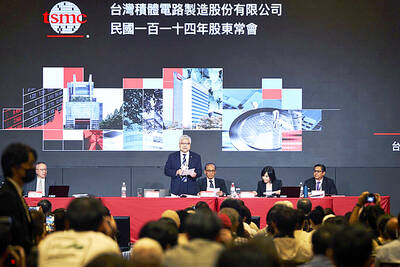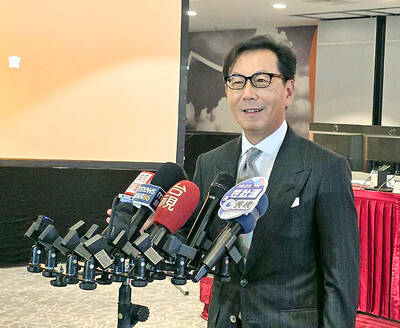Jack Chang (
It's a vision that's being built right now, and it's called PC-Radio. Chang outlined his plan at a recent gathering Taiwanese Internet industry executives, and to hear him talk, you'd think it had already happened.
"We're not an Internet company," said Chang, who is CEO of the Taipei-based PC-Radio Corp (優越傳信). "We see ourselves as a wireless IP company."
Owned by a consortium of seven Taiwan radio stations, including KISS FM and Philharmonic Radio Taipei (台北愛樂), PC-Radio has been working on its dream for a year already.
"As a radio operator, we saw this as our only opportunity to join the dotcom trend," he said.
The company, with five employees, is currently building out a series of four transmitters across central Taiwan in preparation for test broadcasts. An islandwide network will consist of around 20 transmitters at a total cost of NT$100 million. But that's only half of the equation. Chang is betting that PCs of the future will have an aerial and reception DSP (digital signal processing) chipset. With that little addition, at a cost of US$20, users will be able to receive PC-Radio's data broadcasts.
"I could broadcast anything," he said. "It could be CNN over IP, or TTV or anything."
PC-Radio, thanks to its parents' political connections, has already received islandwide licenses to broadcast at 213.36Mhz, which is channel 13 on VHF Band 3. That gives him a broadcast capacity of 1.25Mbps which can be split up any way necessary.
PC-Radio is the Taiwan radio industry's answer to Web-casting, the bandwidth-heavy method for radio stations and Net-only broadcasters to transmit to PC users' desktops. The problem with Web-casting is that it is not true broadcasting. Each extra user requires extra capacity whereas broadcasting has a fixed cost no matter how large the audience.
"The problem with the Internet is that when it was designed, nobody thought that maybe the Internet could be a mass communication device," Chang explained. Instead, the technology of the Internet is essentially point-to-point in nature. Each packet of data must have a final deliver address before it can be sent. With broadcasting, you send out the information and there's no looking back.
While true point-to-multipoint broadcasting is possible over fiber lines, such a change would require full-scale replacement of routers and servers. The easier alternative is wireless, with the only requirement being transmitters and inexpensive DSP receivers. In fact, the trend for wireless is software-based tuning where a single device can tune into any broadcast frequency, FM and AM radio, TV, cellphones or even satellites.
It's a trend that PC-Radio is relying on if it hopes to get anyone to tune in to its signal. Exactly what it will broadcast depends on its customers. "We're not at that stage yet," Chang conceded.
But the plan is to sign up educational institutions, such as English schools, who will pay PC-Radio to use its platform allowing them to broadcast lectures in real time to students' PCs. The current platform is unencrypted, which means anyone could tune in. As yet, the revenue model is hazy.
"The revenue would come from providing the platform, but we're currently subsidized by FM radio operations," Chang said.
But why would an English school pay to broadcast their lectures when non-paying students could tune in?
"The catch is, you don't air the whole lecture. You just tell them this is what you get if you come to us," Chang said.

CAUTIOUS RECOVERY: While the manufacturing sector returned to growth amid the US-China trade truce, firms remain wary as uncertainty clouds the outlook, the CIER said The local manufacturing sector returned to expansion last month, as the official purchasing managers’ index (PMI) rose 2.1 points to 51.0, driven by a temporary easing in US-China trade tensions, the Chung-Hua Institution for Economic Research (CIER, 中華經濟研究院) said yesterday. The PMI gauges the health of the manufacturing industry, with readings above 50 indicating expansion and those below 50 signaling contraction. “Firms are not as pessimistic as they were in April, but they remain far from optimistic,” CIER president Lien Hsien-ming (連賢明) said at a news conference. The full impact of US tariff decisions is unlikely to become clear until later this month

Popular vape brands such as Geek Bar might get more expensive in the US — if you can find them at all. Shipments of vapes from China to the US ground to a near halt last month from a year ago, official data showed, hit by US President Donald Trump’s tariffs and a crackdown on unauthorized e-cigarettes in the world’s biggest market for smoking alternatives. That includes Geek Bar, a brand of flavored vapes that is not authorized to sell in the US, but which had been widely available due to porous import controls. One retailer, who asked not to be named, because

CHIP DUTIES: TSMC said it voiced its concerns to Washington about tariffs, telling the US commerce department that it wants ‘fair treatment’ to protect its competitiveness Taiwan Semiconductor Manufacturing Co (TSMC, 台積電) yesterday reiterated robust business prospects for this year as strong artificial intelligence (AI) chip demand from Nvidia Corp and other customers would absorb the impacts of US tariffs. “The impact of tariffs would be indirect, as the custom tax is the importers’ responsibility, not the exporters,” TSMC chairman and chief executive officer C.C. Wei (魏哲家) said at the chipmaker’s annual shareholders’ meeting in Hsinchu City. TSMC’s business could be affected if people become reluctant to buy electronics due to inflated prices, Wei said. In addition, the chipmaker has voiced its concern to the US Department of Commerce

STILL LOADED: Last year’s richest person, Quanta Computer Inc chairman Barry Lam, dropped to second place despite an 8 percent increase in his wealth to US$12.6 billion Staff writer, with CNA Daniel Tsai (蔡明忠) and Richard Tsai (蔡明興), the brothers who run Fubon Group (富邦集團), topped the Forbes list of Taiwan’s 50 richest people this year, released on Wednesday in New York. The magazine said that a stronger New Taiwan dollar pushed the combined wealth of Taiwan’s 50 richest people up 13 percent, from US$174 billion to US$197 billion, with 36 of the people on the list seeing their wealth increase. That came as Taiwan’s economy grew 4.6 percent last year, its fastest pace in three years, driven by the strong performance of the semiconductor industry, the magazine said. The Tsai